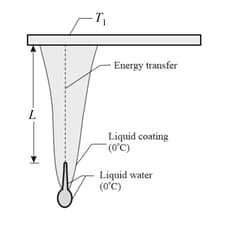Define heat current.
Important Questions on Thermal Phenomena
What is thermal conductivity? What is its SI unit?
“The constituent particles of a material change position during conduction of heat through it.”
A conducting cylindrical rod of uniform cross-sectional area is kept between two large chambers which are at temperatures and , respectively. The conductivity of the rod increases with , where is distance from end. The temperature profile of the rod in steady-state will be as:

Liquid water coats an active (growing) icicle and extends up a short, narrow tube along the central axis. Because the water-ice interface must have a temperature of , the water in the tube cannot lose energy through the sides of the icicle or down through the tip because there is no temperature change in those directions. It can lose energy and freeze only by sending energy up (through distance ) to the top of the icicle, where the temperature can be below Take and Assume that the central tube and the upward conduction path both have cross-sectional area The thermal conductivity of ice is latent heat of fusion is and the density of liquid water is .

